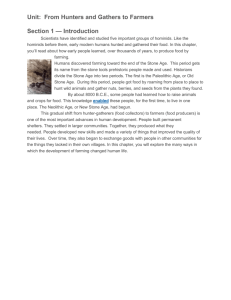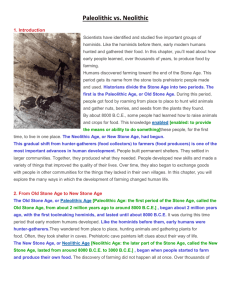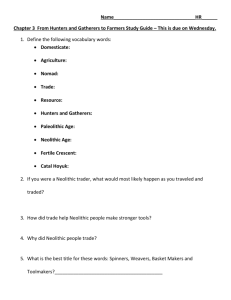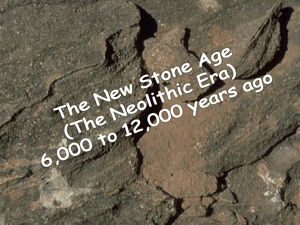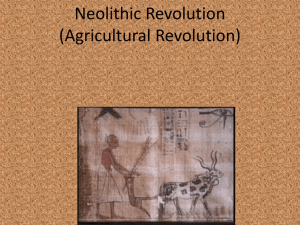Chapter 3: From Hunters and Gatherers to Farmers 3.2 : From
advertisement
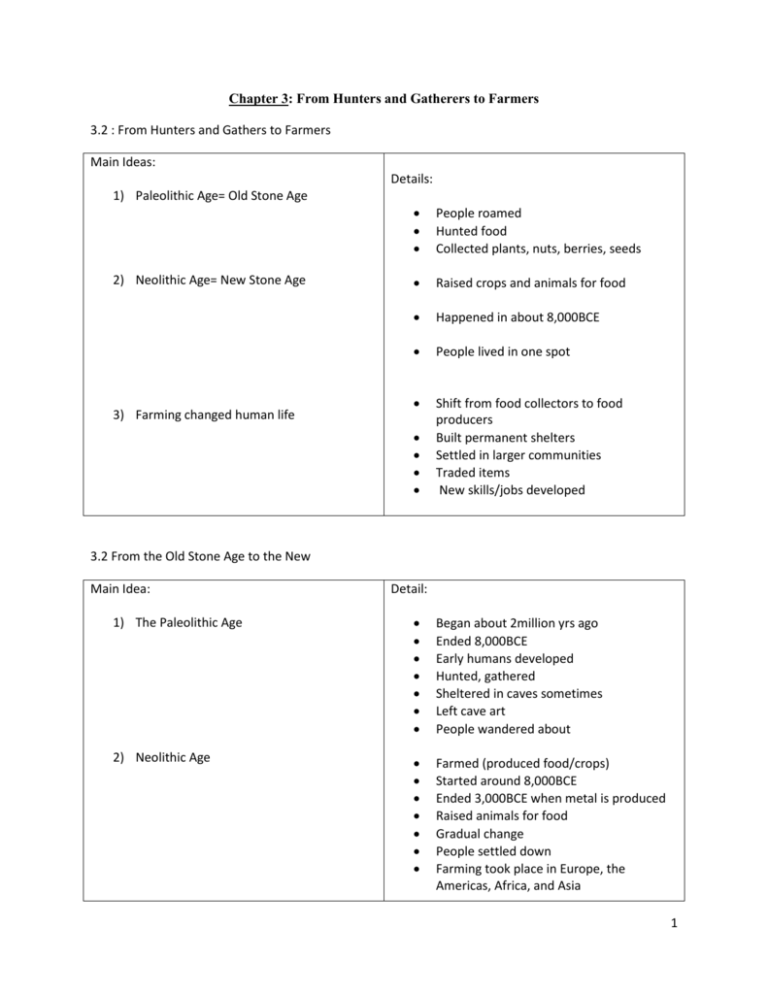
Chapter 3: From Hunters and Gatherers to Farmers 3.2 : From Hunters and Gathers to Farmers Main Ideas: Details: 1) Paleolithic Age= Old Stone Age 2) Neolithic Age= New Stone Age 3) Farming changed human life People roamed Hunted food Collected plants, nuts, berries, seeds Raised crops and animals for food Happened in about 8,000BCE People lived in one spot Shift from food collectors to food producers Built permanent shelters Settled in larger communities Traded items New skills/jobs developed 3.2 From the Old Stone Age to the New Main Idea: Detail: 1) The Paleolithic Age Began about 2million yrs ago Ended 8,000BCE Early humans developed Hunted, gathered Sheltered in caves sometimes Left cave art People wandered about 2) Neolithic Age Farmed (produced food/crops) Started around 8,000BCE Ended 3,000BCE when metal is produced Raised animals for food Gradual change People settled down Farming took place in Europe, the Americas, Africa, and Asia 1 3) Neolithic Settlements Arise Located in the Fertile Crescent (see map) Towns= Catal Hoyuk, Jericho, Jarmo Larger communities Better clothes, tools, Life is more comfortable, and safer They trade 3.3 Creating a Stable Food Supply Main Ideas: Details: 1) Paleolithic Food Hunting&gathering Food supply not stable or dependable Plants sometimes grew scarce Hunting was dangerous 2) Neolithic Agriculture Developed Domesticated Animals (meat)(milk) Goats, sheep(wool), cows Mules did work People controlled their food supply Grow and harvest crops. 3.4: Making Permanent Shelters Main Idea: Details: People lived in caves, tent-like shelters Temporary shelters People were nomads and moved to find food 2) Neolithic Houses (outside) 3) Neolithic Houses (inside) Houses were rectangular or round Made of mud bricks (also wood and stones) Entrances were high up on walls Several rooms Food storage and cooking pits (lined with clay) in the floors 1) Paleolithic Shelters 2 4) Permanent shelters were an Important development Protection from harsh weather Protection from wild animals New cooking methods Longer lasting so communities grew Life grew more comfortable 3.5: Establishing Permanent Settlements Main Ideas: Details: 1) Towns and Villages Grow Farming allowed this growth Permanent shelters made Two examples are Catal Hoyuk and Jericho 2) Lives become more efficient and cooperative Work was divided up Some people farmed, and some built homes, some made tools Tasks got done more quickly with cooperation Lives grew more comfortable Changes lead to increased cooperation 3.6: Developing New Jobs Main Ideas: Details: 1) Specialized skills developed Food supply is steady In Catal Hoyuk in 6,000BCE people are weavers, basket makers, tool makers and traders 2) Skills improve In Catal Hoyuk farmers had 14 kinds of plants they grew The skills of weaving, spinning brought better clothes of wool and linen Sharp flint tools are produced 3) A sense of comfort and beauty increases People decorated pottery w/shapes Polished stones for jewelry Extra rooms built on homes to honor the gods Community life gained variety 3 3.7: Beginning to Trade Main Idea: 1) Trade grew more common in Neolithic times 2) Resources (stuff) that was traded 3) Trade brought contact with other cultures Details: Trade was rare in Paleo-times Resources gathered from afar Traders traveled 100s of miles Rode donkeys, crossed mts, crossed deserts, sailed the Mediterranean Obsidian Hematite Shells Flint (for arrowheads, cutting tools) Spreading of ideas and knowledge 4





